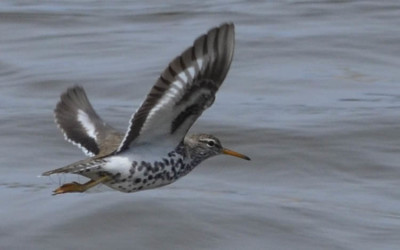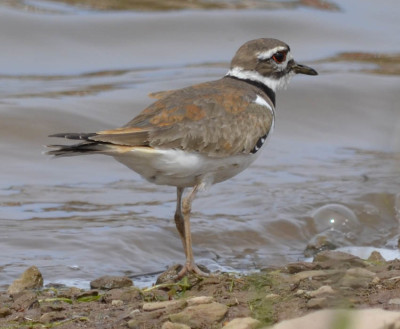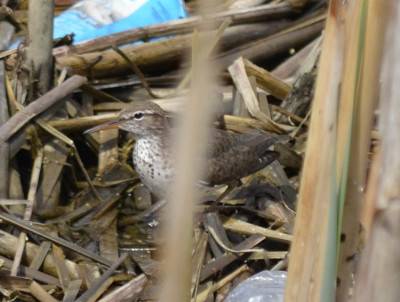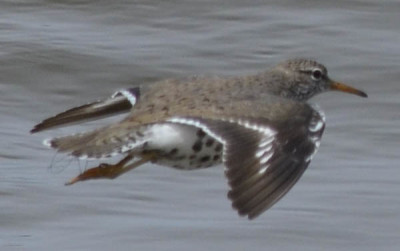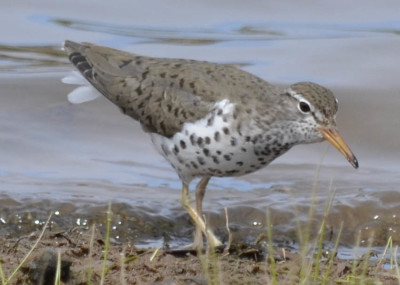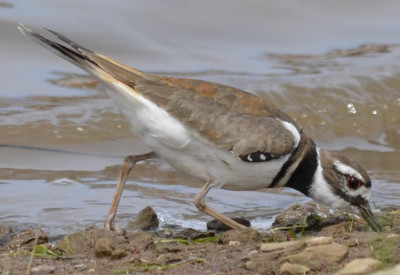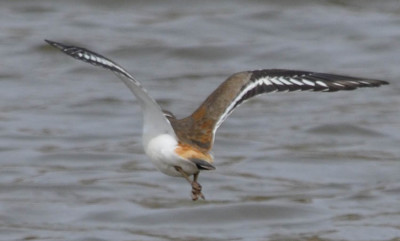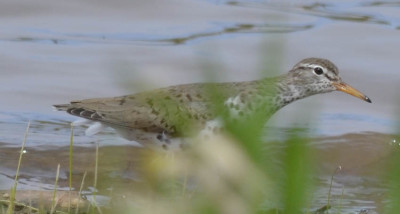There is a pair of storm water runoff ponds in Oakville, Ontario, just south of Dundas at 6th Line. The surrounding park is mostly a combination of over-fertilized green grass and over-grown thistles and burdock. Still, there are some Dogwood shrubs, some poplar trees, a few cedars and spruces and some patches of cattails. While I wouldn’t put it on the list of “best places to bird in Oakville” it’s not the worst place either. Over the years I’ve seen Caspian Terns, Teal and Ring-Necked Ducks here. So today after dropping my youngest off at a celebration, I stopped for a quick ramble round the ponds. Imagine my surprise when I noticed a sandpiper a bit larger than a robin walking along the shore, poking into the sand and silt looking for snacks.
The Most Common Shore Bird in Civilized Spots is the Killdeer
My first thought was that it was not a Killdeer. Although Killdeer do poke along the shore line and I know they nest near these storm water ponds they also have a distinctive colouring and they very seldom stay quiet for more than a few minutes.
Killdeer are commonly found in school yards and parks.
This bird, skulking through the cattails, had spots on its chest, not a pair of thick black stripes.
And when it flew, which of course it did as soon as I tried to creep into position for a clear photo, it did not have the rusty rump patch of a killdeer either. Instead, it had a noticeable thin white bar on each wing.
And it also had a friend! Suddenly there were two birds flying quickly along the edge of the shore searching for a safe place to land. They flew silently and ignored the aerial acrobatics of the Barn and Rough Winged Swallows that were also sailing through the wind-tossed air.
What Was This Speckled Sandpiper?
I still wasn’t entirely sure what kind of Sandpipers these were. (I can’t see any details on the small screen on my camera in full sun. I can’t even tell if I’ve taken a photo with decent focus.) So I started crossing a “meadow” of beaten-down burdock, sprouting lush thistles, and mud, to see if the birds had landed around a small point of land jutting into the pond.
And one had! Now I could see the bird clearly. Its orange bill (with a dark tip) was clearly visible. Its dappled chest showed distinct spots. Its legs were yellow, more or less. It was also walking quickly along the shore, stopping only briefly here and there. I had spotted a Spotted Sandpiper.
A Convenient Comparison to a Killdeer
It was soon out of view. As if to provide a quick review of the differences, a Killdeer then flew in, calling, and landed on the same stretch of silt. It stood there reminding me of its huge orange eyes, its black necklaces and, as it flew off, its rufous rump.
Why Would Sandpipers be Patrolling the Storm Water Pond Shores?
I doubt these two Sandpipers intend to stay at the lagoons. I’ve seen reports of shore birds on the move on the BirdAlert website. I expect they are migrating through and stopped to see what food was available.
When I checked the AllAboutBirds website I found that Spotted Sandpipers nest in southern Ontario. In fact they are very widespread and nest in all of Canada. I still doubt that the storm water lagoons offer enough food, however, to support the adults much less any youngsters.
Another interesting fact the Cornell site reported is that the male Sandpipers incubate the eggs and raise the young, sometimes with no help from the female.
As for food, it says they eat midges, flies and grasshoppers as well as other prey more common at the shore such as snails, worms and small crustaceans. This willingness to eat a variety of foods probably explains why they are so widespread. It also means I should check back in a few weeks and see if I’m wrong and they are nesting at the ponds.
Overall, I was very pleased I had stopped to check what was at the ponds. Seeing Spotted Sandpipers was an unexpected treat.
Related Reading
Join In
Have you ever found interesting birds in odd areas? Please share your experiences with a comment.

